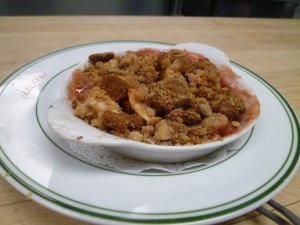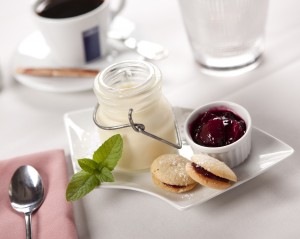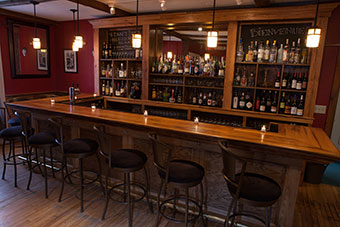Crumble…gotta have it…it’s just one of those things! People love crumble so much, if it’s not on the menu, that’s it, they’re not getting any dessert. I have to say, I love it too. It’s not the most original dessert out there, but when it’s well done (fruit’s not too sweetened, crumble is cooked through — not raw! -) it really always satisfies. I’m convinced that people order it in restaurants because somewhere they feel that it’s healthy, but I’ve had guests assure me that no, they just love it! And it’s the perfect seasonal dessert, too, of course. Whatever fruit looks good, just top it and bake!
So how to make myself more engaged by baking crumble after crumble? I’ve must have literally made thousands of them. Dorie Greenspan, one of my strongest muses, provided an excellent option this past fall: add crushed Speculoos!
What are Speculoos, you ask, and why would I want them in my already-divine crumble? Speculoos are a kind of European ginger snap, my friends, and they are as addictive as any cookie you could want to eat. Crumbled up, mixed with soft butter, and then mixed into your crumble topping, they take the dessert to a whole new level: spicy, warm, yummy with winter fruits like apples and cranberries.
Crumbling stuff up into your crumble … why didn’t I think of this before???
Apple-Cranberry-Speculoos Crumble
8 Granny Smith apples, peeled and chopped into 1/2 inch pieces
1/2 c fresh cranberries
1/2 c sugar
1 T cornstarch
pinch salt
1 t cinnamon
pinch freshly grated nutmeg
1 T lemon juice
-Toss all of the fruit together in a large bowl and set aside for the juices to release while you make the topping.
Topping:
1/2 lb butter, melted and cooled
3 1/2 c all-purpose flour
1 c oats
1 c sugar
1/2 c dark brown sugar
1 t cinnamon
1 t mixed spice for baking
pinch salt
-Toss all ingredients quickly together in a large bowl so that the butter is evenly distributed and mixture looks dry, not in big clumps:
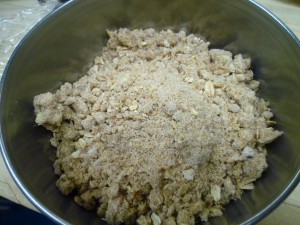 If you don’t want to use the Speculoos, you can stop at this point, put the fruit in the baking dish and top with the crumble. Bake at 375F until well-browned and bubbling (don’t take it out until you’ve got bubbles coming from the middle of the crumble, not just the edges; underbaked crumbles are one of my nemesis!) This is a delicious crumb topping, and by far the best recipe of all that I have tried over the years.
If you don’t want to use the Speculoos, you can stop at this point, put the fruit in the baking dish and top with the crumble. Bake at 375F until well-browned and bubbling (don’t take it out until you’ve got bubbles coming from the middle of the crumble, not just the edges; underbaked crumbles are one of my nemesis!) This is a delicious crumb topping, and by far the best recipe of all that I have tried over the years.
But, if you’d like to take things up a notch, by all means, let’s get the Speculoos in there!

You can buy Biscoff cookies, or these Trader Joe's look-alikes, or just use a nice gingersnap that you make or buy in the supermarket
For this quantity of crumb topping, use one package of cookies and one stick of soft butter.
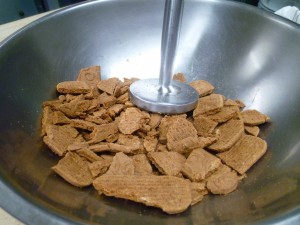
Any heavy kitchen tool will crush these up efficiently. I like to keep a few large chunks so no one forgets that this is a Speculoos Crumble!
Use any heavy implement that you have to hand, a rolling pin, a hammer, express yourself… and crush the cookies in a large metal or wooden bowl with authority until they are crumbs with some nice chunks remaining. Now you have to thoroughly smush the butter into the cookie crumbs, making sure that you evenly distribute the butter. Dorie Greenspan actually just put this topping onto the crumble and baked it. I tried this originally and it is really good and different, a nice change from the crumble doldrums. But it’s a bit sweet (even for me!) with all of those cookies, so I thought it might be nice to mix it into the topping and cut the sweetness a bit. Voila! The Ultimate Crumble…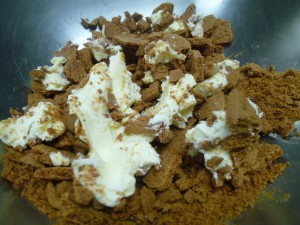 Combine the two toppings and then sprinkle generously on top of the prepared fruit and bake. Any extra crumb topping can be frozen for the next time you are in the mood to bake dessert. They also make a nice topping for pumpkin muffins, if you’d like to try something different, but I guess that’s another story…
Combine the two toppings and then sprinkle generously on top of the prepared fruit and bake. Any extra crumb topping can be frozen for the next time you are in the mood to bake dessert. They also make a nice topping for pumpkin muffins, if you’d like to try something different, but I guess that’s another story…
